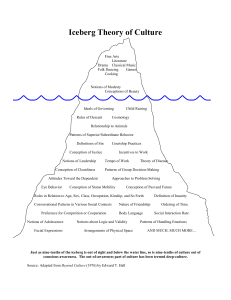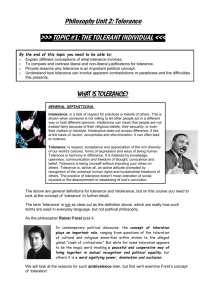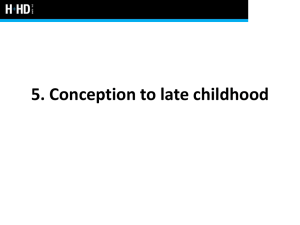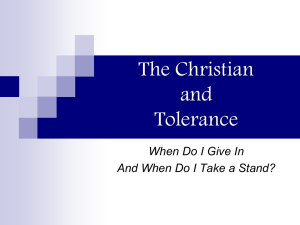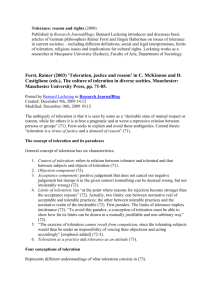1 - The Richmond Philosophy Pages
advertisement
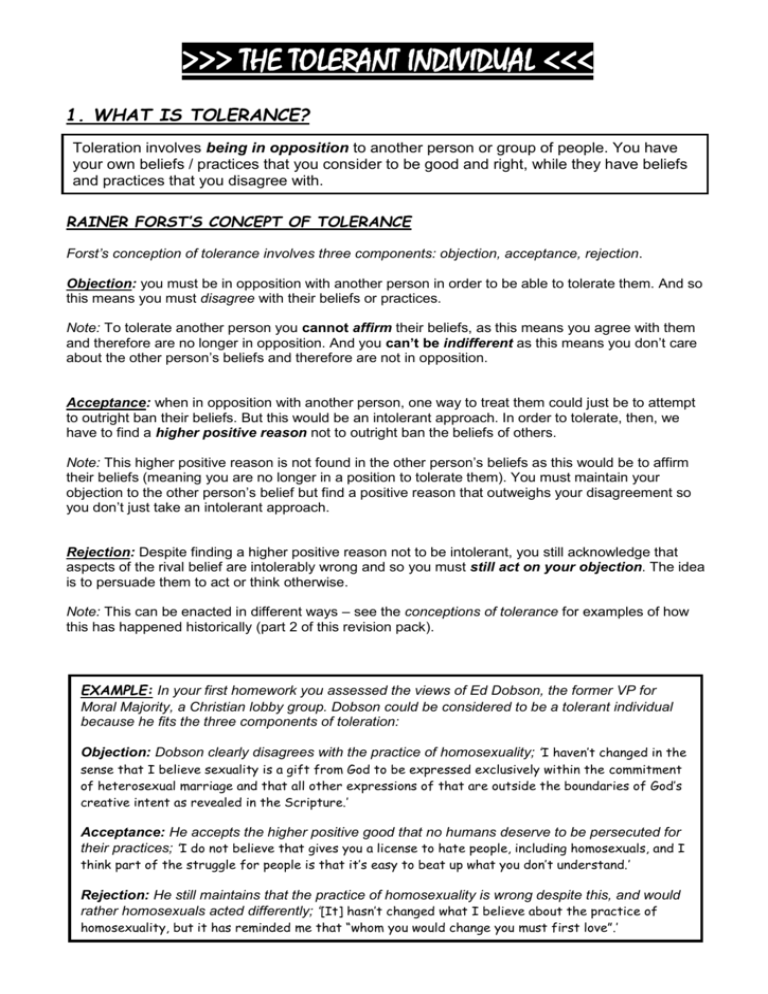
>>> THE TOLERANT INDIVIDUAL <<< 1. WHAT IS TOLERANCE? Toleration involves being in opposition to another person or group of people. You have your own beliefs / practices that you consider to be good and right, while they have beliefs and practices that you disagree with. RAINER FORST’S CONCEPT OF TOLERANCE Forst’s conception of tolerance involves three components: objection, acceptance, rejection. Objection: you must be in opposition with another person in order to be able to tolerate them. And so this means you must disagree with their beliefs or practices. Note: To tolerate another person you cannot affirm their beliefs, as this means you agree with them and therefore are no longer in opposition. And you can’t be indifferent as this means you don’t care about the other person’s beliefs and therefore are not in opposition. Acceptance: when in opposition with another person, one way to treat them could just be to attempt to outright ban their beliefs. But this would be an intolerant approach. In order to tolerate, then, we have to find a higher positive reason not to outright ban the beliefs of others. Note: This higher positive reason is not found in the other person’s beliefs as this would be to affirm their beliefs (meaning you are no longer in a position to tolerate them). You must maintain your objection to the other person’s belief but find a positive reason that outweighs your disagreement so you don’t just take an intolerant approach. Rejection: Despite finding a higher positive reason not to be intolerant, you still acknowledge that aspects of the rival belief are intolerably wrong and so you must still act on your objection. The idea is to persuade them to act or think otherwise. Note: This can be enacted in different ways – see the conceptions of tolerance for examples of how this has happened historically (part 2 of this revision pack). EXAMPLE: In your first homework you assessed the views of Ed Dobson, the former VP for Moral Majority, a Christian lobby group. Dobson could be considered to be a tolerant individual because he fits the three components of toleration: Objection: Dobson clearly disagrees with the practice of homosexuality; ‘I haven’t changed in the sense that I believe sexuality is a gift from God to be expressed exclusively within the commitment of heterosexual marriage and that all other expressions of that are outside the boundaries of God’s creative intent as revealed in the Scripture.’ Acceptance: He accepts the higher positive good that no humans deserve to be persecuted for their practices; ‘I do not believe that gives you a license to hate people, including homosexuals, and I think part of the struggle for people is that it’s easy to beat up what you don’t understand.’ Rejection: He still maintains that the practice of homosexuality is wrong despite this, and would rather homosexuals acted differently; ‘[It] hasn’t changed what I believe about the practice of homosexuality, but it has reminded me that “whom you would change you must first love”.’ 2. HOW IS TOLERANCE ENACTED? The concept of tolerance is essentially contested. This means that the concept is valuable, but what is valuable about it is not immediately obvious, and so the concept becomes open to interpretation and various understandings. There are four ways the concept of tolerance can work in practice, these are the four conceptions of tolerance: the permission conception, the coexistence conception, the respect conception (in both its formal and qualitative equality models) and the esteem conception. The Permission Conception: o o o o o Toleration here involves a hierarchical power relation. This means a majority tolerates a minority. The majority allows the minority to practice their beliefs in the private sphere (i.e. homes, places of worship, private communal places like cafes, bars etc) but they have limited rights in the public sphere compared to those in the majority. This means the minority are treated as inferiors, or second class citizens: they do not claim equal, social or political rights. Here toleration is a negative term, signifying power, domination and exclusion. This is why Goethe said: ‘Tolerance should be a temporary attitude only: it must lead to recognition. To tolerate means to insult.’ The point of this toleration is to ease conflict by not outright banning the minority practices, but typically, the permission conception leads to rebellion against the injustice of such toleration. EXAMPLES: o Segregation in the USA: between the 1870s and 1960s black Americans were free from slavery yet they were still treated as 2nd class citizens through legal segregation (the Jim Crow laws) – this meant, for example, that they were unable to go to the same schools as white children, were restricted to certain parts of public transport and even had to drink from separate water fountains from white people. Through acts of civil disobedience (non-compliance with segregation laws) black Americans eventually won equal rights to white people. o Suffragettes in the UK: the majority with social power in the UK have long been males, but females (the minority social power) rebelled against their injustices in the late 19 th and early 20th century. Suffragettes carried out direct action such as chaining themselves to railings, setting fire to mailbox contents, smashing windows and on occasions setting off bombs. In 1918 women won the right to vote, under great restrictions which have deteriorated over time to create more equality between men and women. The Coexistence Conception: o o o o o This involves seeking a peaceful coexistence between groups that are equal in terms of size or social power. What is important here is that tolerance involves a reciprocal compromise: all groups tolerate each other for their own benefit (i.e. a stable society). This mutual toleration means there is a horizontal power relation: each group is both the subject (tolerating) and the object (tolerated) of toleration. However, there is a distinct lack of respect for the other groups, since toleration is for each group’s own benefit. This means the civility between the different groups will not necessarily last. EXAMPLES: o The Northern Ireland peace process: The Unionists (who want Northern Ireland to remain part of the UK) and the Republicans (who want NI to be absorbed into the Republic of Ireland) reciprocally agreed to put down their arms and to cease their acts of violence and intimidation against the supporters of each group for the sake of peace in Northern Ireland. There is still mutual distrust, however, as evident from sporadic reports of attacks from splinter groups associated with both sides, over the past few years. The peace process is a constant and continuous struggle. o The Israel / Palestine conflict: President Obama’s aim is to create two states that can peacefully coexist with one another. The Israelis and Palestinians may not ever get along, or forget past atrocities, but in order for there to be any kind of resolution to the death and destruction of the conflict both sides will have to make a reciprocal compromise and agree to move on. The Respect Conception: Both models of the respect conception involves different groups within a society abiding by the universal good / values of that society (e.g. that others are moral equals and have the same rights as us). This goes beyond peaceful coexistence as the idea is that we don’t just reciprocally compromise, we understand that everyone is of equal value to ourselves. The Formal Equality model: o o o This is the equivalent of assimilation. Diverse groups are limited to expressing their cultural identity in the private sphere, while in the public sphere all groups submit to the universal identity of that society. This strict division between the public and private sphere is intended to create a society where all are treated equally and without any special preference. EXAMPLE: This model is clearly exhibited in the ‘secular republicanism’ of the French authorities who hold that religious symbols have no place in public schools in which children are educated to be autonomous citizens (meaning Muslim students are not allowed to wear headscarves to school just as Christians aren’t allowed to wear a necklace with a cross). The idea is that in the public sphere everyone submits to the secular identity of the French society which is based around the three pillars of: fraternity, equality and liberty. Problems with this model include a lack of social mobility for ethnic minorities who aren’t supposed to be treated as ‘ethnic’ yet are discriminated against in terms of employment, and sometimes by the law (hence the suburban riots of Paris over the past two decades). The Qualitative Equality model: o o o o This is the equivalent of integration. Diverse groups submit to the universal identity of the society as a whole, yet it is recognised that some cultural identities need to be expressed in the public sphere. If this is acceptable then a person may be respected both as a political equal and as a person with specific needs (i.e. a certain distinct ethical-cultural identity) that should be tolerated. Despite their being universal values, diversity is acknowledged in order to enforce these universal values e.g. to ensure equality we need anti-discrimination laws in employment. EXAMPLE: This model is clearly exhibited in the ‘multiculturalism’ of the U.K. Here we have the universal values of democracy and the law, for example, yet some groups will be exempt from the latter if their cultural identity requires this. E.g. Sikhs being allowed to ride motorcycles without helmets, pupils being allowed to opt out of otherwise compulsory Religious Studies lessons in high school if their parents disagree with them being exposed to other religious beliefs. There are also anti-discrimination laws in the work place that acknowledge the ethnic diversity, sexuality and disabilities of potential employees. Problems with this model include anger at apparent special preferences for certain groups in society over others, the notion of positive discrimination in the workplace where some persons are chosen over others in order to have a balance of ethnicity in the workforce, issues of values such as freedom of speech. The Esteem Conception: o o o o This goes beyond the respect conception in that we see value in the practices / beliefs we are actually tolerating (and hence necessarily still objecting to at some level). This involves the notion of ‘reserved esteem’, a kind of positive acceptance of a belief that for some reason you still find is not as attractive as the one you hold. This conception of tolerance involves a minimal rejection of the practice / belief. Such a practice / belief is objected to, but is not held in contempt. An example could be one based in school, where pupils dislike the disruptive behaviour of their peers as they believe education is a route to self-progression rather than showing off, yet they might also admire aspects of their behaviour such as attempts to challenge and resist authority. EXAMPLE: This has not been successfully enacted on a societal scale as far as I know, but this is what the very important 20th century political philosopher John Rawls would like to see practiced in society: o A tolerant society will not exercise power (e.g. through legal or social sanctions) except by appealing to reasons that everyone reasonable can accept. o Social structures and laws must not favour one conception of the good over another. This model for society is akin to the esteem conception since despite objections, we recognise that every group deserves the same rights as our own, the rejection component of tolerance is minimal here.
